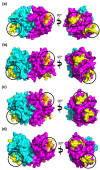A Review of the Emerging White Chick Hatchery Disease
- PMID: 34960704
- PMCID: PMC8703500
- DOI: 10.3390/v13122435
A Review of the Emerging White Chick Hatchery Disease
Abstract
White chick hatchery disease is an emerging disease of broiler chicks with which the virus, chicken astrovirus, has been associated. Adult birds typically show no obvious clinical signs of infection, although some broiler breeder flocks have experienced slight egg drops. Substantial decreases in hatching are experienced over a two-week period, with an increase in mid-to-late embryo deaths, chicks too weak to hatch and pale, runted chicks with high mortality. Chicken astrovirus is an enteric virus, and strains are typically transmitted horizontally within flocks via the faecal-oral route; however, dead-in-shell embryos and weak, pale hatchlings indicate vertical transmission of the strains associated with white chick hatchery disease. Hatch levels are typically restored after two weeks when seroconversion of the hens to chicken astrovirus has occurred. Currently, there are no commercial vaccines available for the virus; therefore, the only means of protection is by good levels of biosecurity. This review aims to outline the current understanding regarding white chick hatchery disease in broiler chick flocks suffering from severe early mortality and increased embryo death in countries worldwide.
Keywords: chicken astrovirus; hatchery disease; vertical transmission; white chick.
Conflict of interest statement
The authors declare no conflict of interest.
Figures





References
-
- Mazaheri A., Prusas C., Voß M., Hess M. Vertical transmission of fowl adenovirus serotype 4 investigated in specified patho-gen-free birds after experimental infection. Arch. Fur Geflugelkd. 2003;67:6–10.
-
- Linden J. Vertically Transmitted Health Issues in Poultry. [(accessed on 6 May 2021)]. Available online: https://thepoultrysite.com/articles/vertically-transmitted-health-issues...
Publication types
MeSH terms
LinkOut - more resources
Full Text Sources

